Design of Non-Structural Practices for Sustainable Water Quality Improvement in an Urban River: A Case Study of South Korea
Abstract
:1. Introduction
2. Materials and Methods
2.1. Study Area
2.2. Urban River Water Quality Pollution Monitoring and Pollution Source Investigation
2.3. Desing of Non-Structural Practices for Sustainable Urban Stream Management
3. Results
3.1. Water Quality Monitoring and Detailed Investigation of Pollution Sources in Main Inflowing Streams
3.1.1. Analysis Results of Water Quality Concentrations and Pollution Loadings in Main Stream and Major Tributaries
3.1.2. On-Site Detailed Investigation for Identifying Unknown Sources and Main Pollution
3.1.3. Analysis of Urban River Pollution Sources and Assessment of Water Quality Contamination Contributions
3.2. Establishment and Activities of Citizen Participation Governance for Sustainable Urban Stream Water Quality Management
3.2.1. Establishment of Citizen Participation Governance
- Resident participation water quality monitoring: Selection of river water quality measurement points and regular water quality monitoring using simple measurement kits.
- Environmental cleanup and surveillance: Regular environmental cleanup activities and conducting surveillance activities for main cause analysis in case of water quality pollution, in coordination with citizen monitoring activities.
- Water-Environmental Education: Education for residents related to water and environment and promotion of eco-friendly detergents.
3.2.2. Citizen Participation Water Quality Monitoring
3.2.3. Analysis of Water Quality Pollution Reduction Effects in the Domestic Sector through EM Detergent
4. Conclusions
Author Contributions
Funding
Institutional Review Board Statement
Informed Consent Statement
Data Availability Statement
Conflicts of Interest
References
- Coles, J.F.; McMahon, G.; Bell, A.H.; Brown, L.R.; Fitzpatrick, F.A.; Scudder Eikenberry, B.C.; Woodside, M.D.; Cuffney, T.F.; Bryant, W.L.; Cappiella, K.; et al. Effects of urban development on stream ecosystems in nine metropolitan study areas across the United States: U.S. Geol. Surv. Circ. 2012, 1373, 138. [Google Scholar]
- Yang, S.; Liang, M.; Qin, Z. A novel assessment considering spatial and temporal variations of water quality to identify pollution sources in urban rivers. Sci. Rep. 2021, 11, 8714. [Google Scholar] [CrossRef]
- Fathollahzadeh, H.; Kaczala, F.; Bhatnagar, A.; Hogland, W. Significance of environmental dredging on metal mobility from contaminated sediments in the Oskarshamn Harbor, Sweden. Chemosphere 2015, 119, 445–451. [Google Scholar] [CrossRef] [PubMed]
- Chen, M.; Cui, J.; Lin, J.; Ding, S.; Gong, M.; Ren, M.; Tsang, D.C. Successful control of internal phosphorus loading after sediment dredging for 6, years: A field assessment using high-resolution sampling techniques. Sci. Total Environ. 2018, 616, 927–936. [Google Scholar] [CrossRef]
- Jing, L.; Bai, S.; Li, Y.; Peng, Y.; Wu, C.; Liu, J.; Liu, G.; Xie, Z.; Yu, G. Dredging project caused short-term positive effects on lake ecosystem health: A five-year follow-up study at the integrated lake ecosystem level. Sci. Total Environ. 2019, 686, 753–763. [Google Scholar] [CrossRef]
- Vezzulli, L.; Pruzzo, C.; Fabiano, M. Response of the bacterial community to in situ bioremediation of organic-rich sediments. Mar. Pollut. Bull. 2004, 49, 740–751. [Google Scholar] [CrossRef]
- Jing, S.R.; Lin, Y.F. Seasonal Effects on Ammonium Nitrogen Removal by Constructed Wetlands Treating Polluted River Water in Southern Taiwan. Environ. Pollut. 2004, 127, 291–301. [Google Scholar] [CrossRef] [PubMed]
- Jia, H.; Sun, Z.; Li, G. A four-stage constructed wetland system for treating polluted water from an urban river. Ecol. Eng. 2014, 71, 48–55. [Google Scholar] [CrossRef]
- Liu, G.; He, T.; Liu, Y.; Chen, Z.; Li, L.; Huang, Q.; Xie, Z.; Xie, Y.; Wu, L.; Liu, J. Study on the purification effect of aeration-enhanced horizontal subsurface-flow constructed wetland on polluted urban river water. Environ. Sci. Pollut. Res. 2019, 26, 12867–12880. [Google Scholar] [CrossRef] [PubMed]
- Taylor, A.; Wong, T.H.F. Non-Structural Stormwater Quality Best Management Practices: An Overview of Their Use, Value, Cost and Evaluation; Technical Report; CRC for Catchment Hydrology: Melbourn, Australia, 2002. [Google Scholar]
- Guo, H.Y.; Wang, X.R.; Zhu, J.G. Quantification and index of non-point source pollution in Taihu Lake re-gion with GIS. Environ. Geochem. Health 2004, 26, 147–156. [Google Scholar] [CrossRef]
- Ma, J.; Ding, Z.; Wei, G.; Zhao, H.; Huang, T. Sources of water pollution and evolution of water quality in the Wuwei basin of Shiyang river, Northwest China. J. Environ. Manag. 2009, 90, 1168–1177. [Google Scholar] [CrossRef] [PubMed]
- Sun, B.; Zhang, L.; Yang, L.; Zhang, F.; Norse, D.; Zhu, Z. Agricultural non-point source pollution in China: Causes and mitigation measures. Ambio 2012, 41, 370–379. [Google Scholar] [CrossRef]
- Alamanos, A.; Koundouri, P.; Papadaki, L.; Pliakou, T.; Toli, E. Water for Tomorrow: A Living Lab on the Creation of the Science-Policy-Stakeholder Interface. Water 2022, 14, 2879. [Google Scholar] [CrossRef]
- Kaustuv, K.B. Chapter 16—Citizen participation in urban river management. In Managing Urban Rivers; Shinde, V.R., Mishra, R.R., Bhonde, U., Vaidya, H., Eds.; Elsevier: Amsterdam, The Netherlands, 2024; pp. 301–312. ISBN 9780323857031. [Google Scholar] [CrossRef]
- Holt, A.R.; Moug, P.; Lerner, D.N. The network governance of urban river corridors. Ecol. Soc. 2012, 17, 25. [Google Scholar] [CrossRef]
- Laitinen, J.; Katko, T.S.; Hukka, J.J.; Juuti, P.; Juuti, R. Governance and Practices for Achieving Sustainable and Resilient Urban Water Services. Water 2022, 14, 2009. [Google Scholar] [CrossRef]
- Mishra, M.K. Water Governance: Effective Needs for Sustainable Development; ZBW—Leibniz Information Centre for Economics: Hamburg, Germany, 2023. [Google Scholar]
- Heaney, J.; Knight, S.; Friedman, K.; Morales, M.; McCary, J. Bottom-up Approaches to Optimize Urban Water Supply, Wastewater, Stormwater, Reuse, and Watershed Network Systems. In Fifty Years of Watershed Modeling—Past, Present and Future; by an authorized administrator of ECI Digital Archives. 2013. Available online: http://dc.engconfintl.org/watershed/10 (accessed on 10 January 2024).
- Di Baldassarre, G.; Sivapalan, M.; Rusca, M.; Cudennec, C.; Garcia, M.; Kreibich, H. Sociohydrology: Scientific challenges inaddressing the sustainabledevelopment goals. Water Resour. 2019, 55, 6327–6355. [Google Scholar] [CrossRef] [PubMed]
- Ito, M. Murasaki River/City of Kitakyushu, Japan River Restoration Network; Panel on Urban Water/River Front Redevelopment: Tokyo, Japan, 2011. [Google Scholar]
- Murasaki River Basin Development Office. Murasaki River My Town My River Story; Construction Bureau: City of Kitakyushu, Japan, 1996. (In Japanese) [Google Scholar]
- Pecorelli, J.P.; Macphie, K.H.; Hebditch, C.; Clifton-Dey, D.R.J.; Thornhill, I.; Debney, A.J. Using citizen science to improve the conservation of the European eel (Anguilla anguilla) in the Thames River Basin District. Freshw. Sci. 2019, 38, 281–291. [Google Scholar] [CrossRef]
- Garvey, J. ODU, Elizabeth River Project Announce Collaborative Initiative. News Items 2020, 68. Available online: https://digitalcommons.odu.edu/odurc_news/68 (accessed on 10 January 2024).
- Nadine, V.; Gerner, I.; Caroline, W.; Kristina, W.; Clemens, S.; Timo, W.; André, N.; Gerardo, A.; Manuel, L.; Sebastian, B. Large-scale river restoration pays off: A case study of ecosystem service valuation for the Emscher restoration generation project. Ecosyst. Serv. 2018, 30 Pt B, 327–338. [Google Scholar] [CrossRef]
- Shim, U.B.; Kwon, T.J. Cases of River Restoration in Foreign Countries and Implications. J. Land 2009, 334, 42–54. [Google Scholar]
- Bae, M.S.; Lee, E.J. Improvement Measures for Water Environment through Community-Participatory Watershed Management. Chungbuk FOCUS 2015, 113, 5–19. [Google Scholar]
- Kang, D.; So, Y.; Park, K.; Kim, I.; Kim, B. Water Quality Level of the Living Environmental Standards and Regression Analysis in the Major Tributaries of the Nakdong River. J. Environ. Sci. Int. 2019, 28, 357–369. [Google Scholar] [CrossRef]
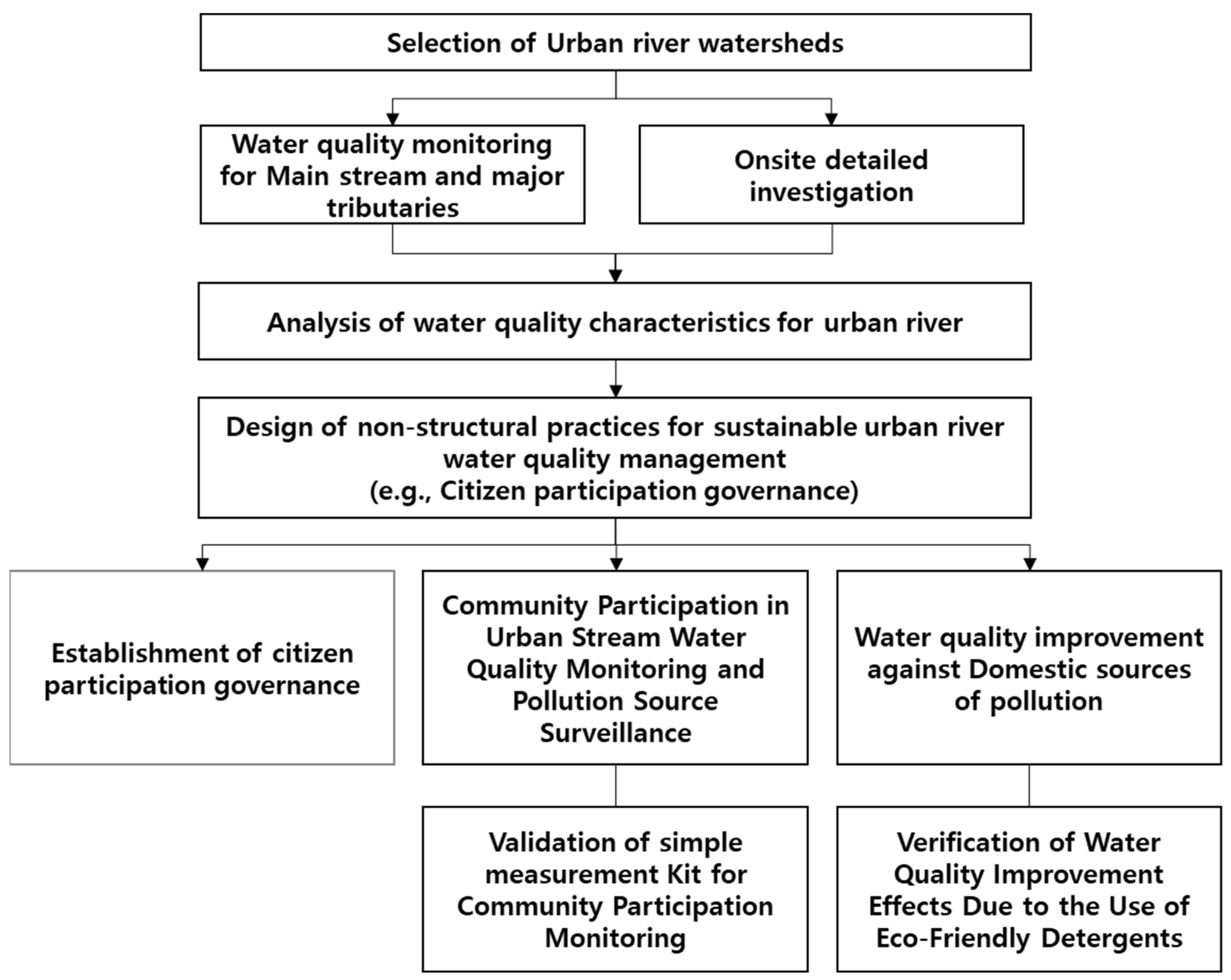

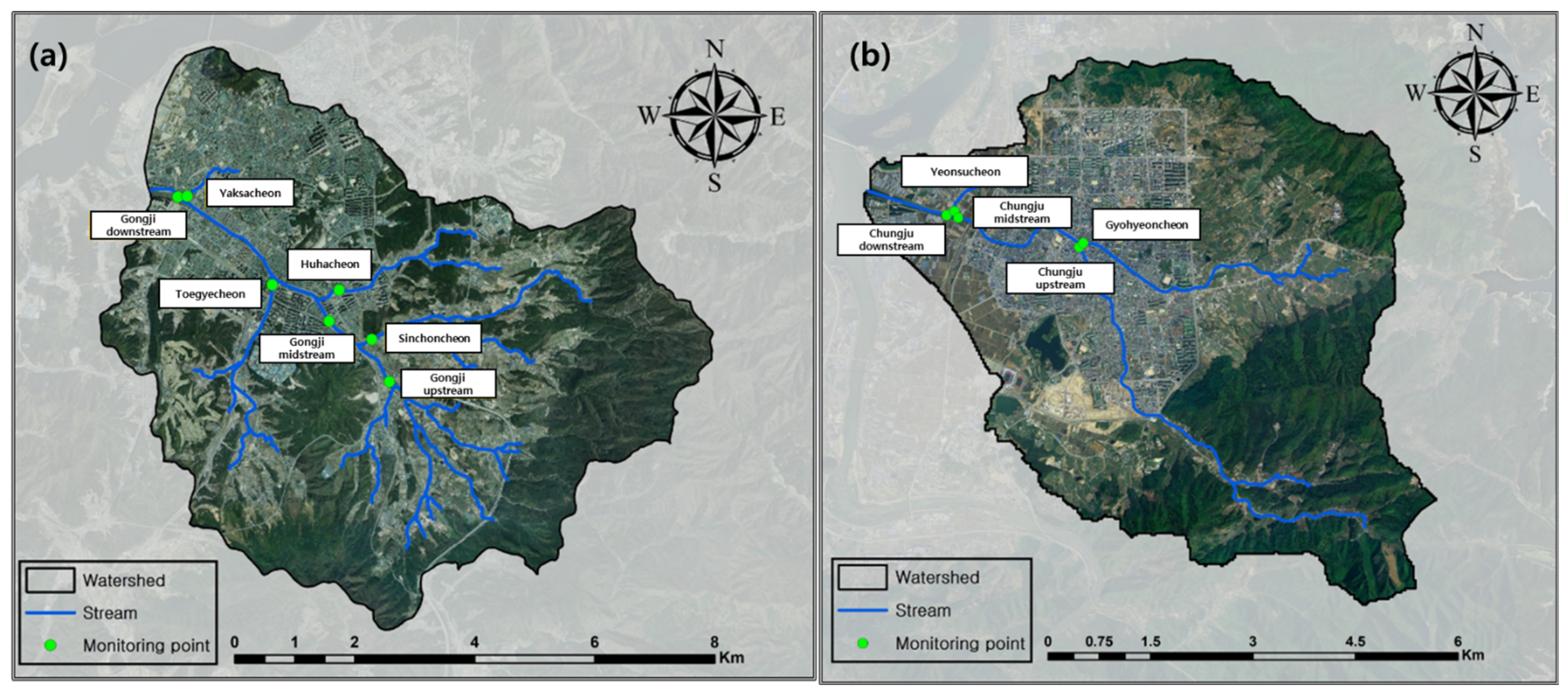
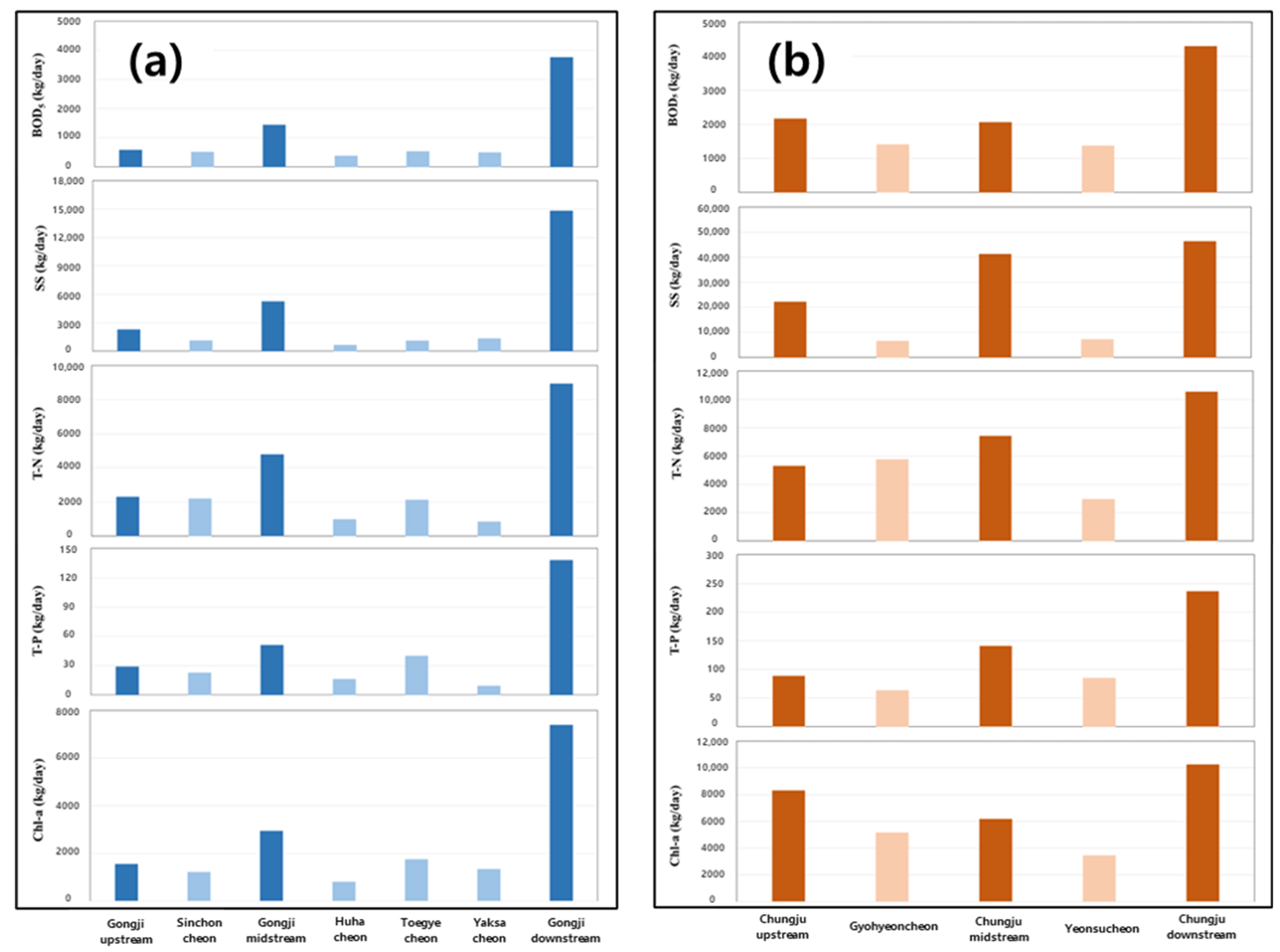
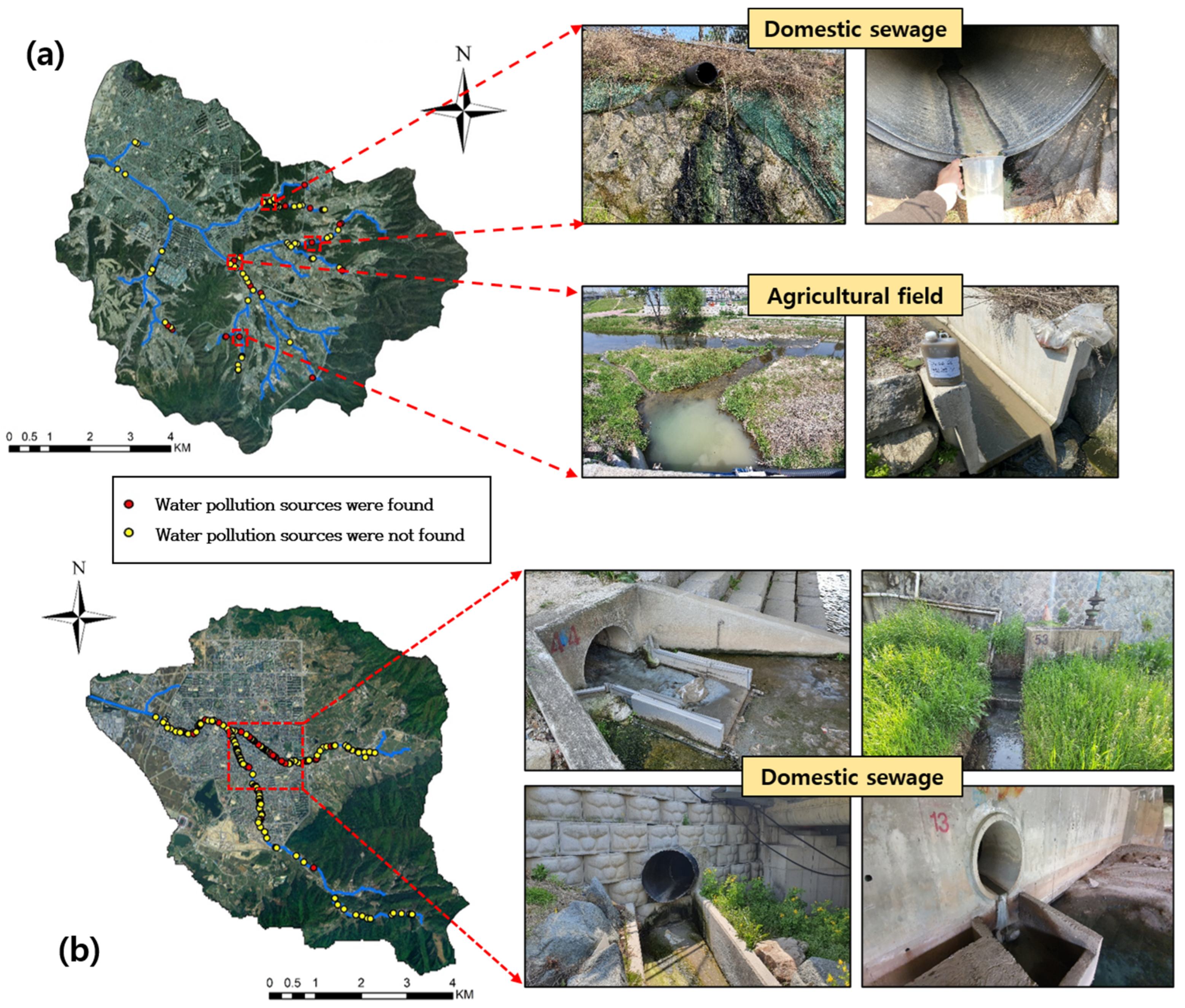
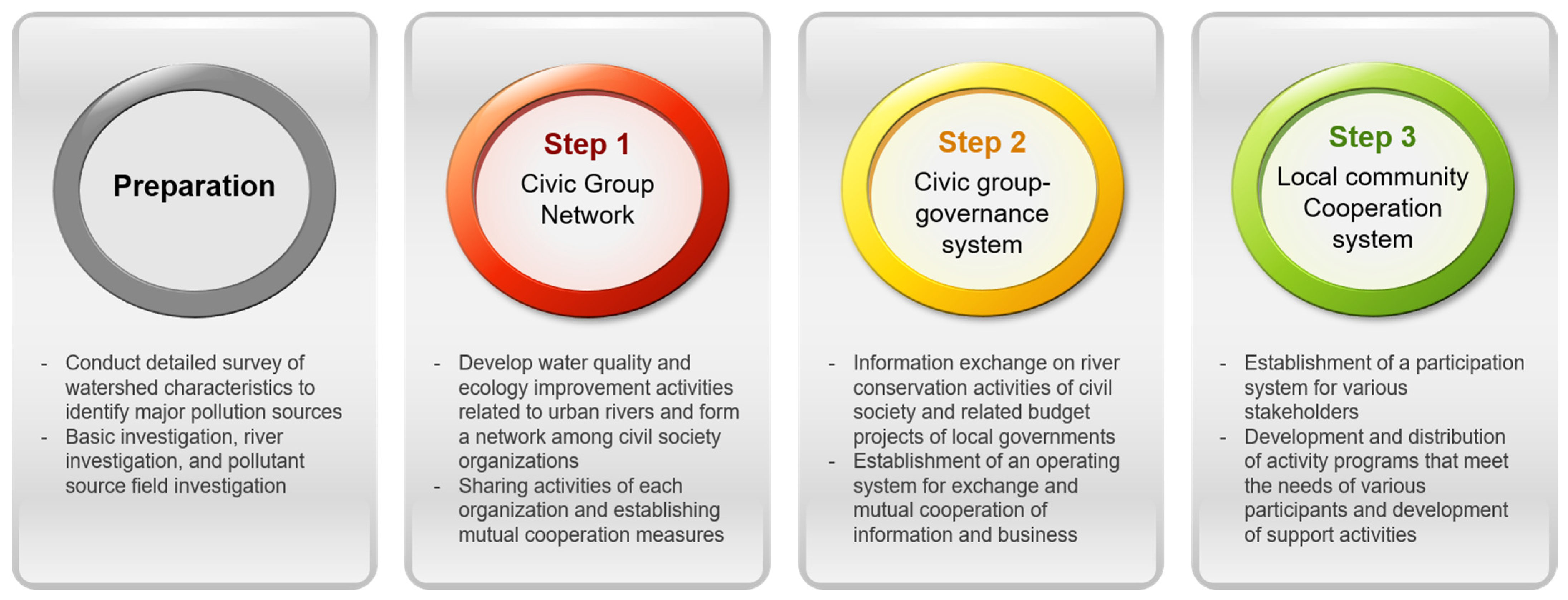
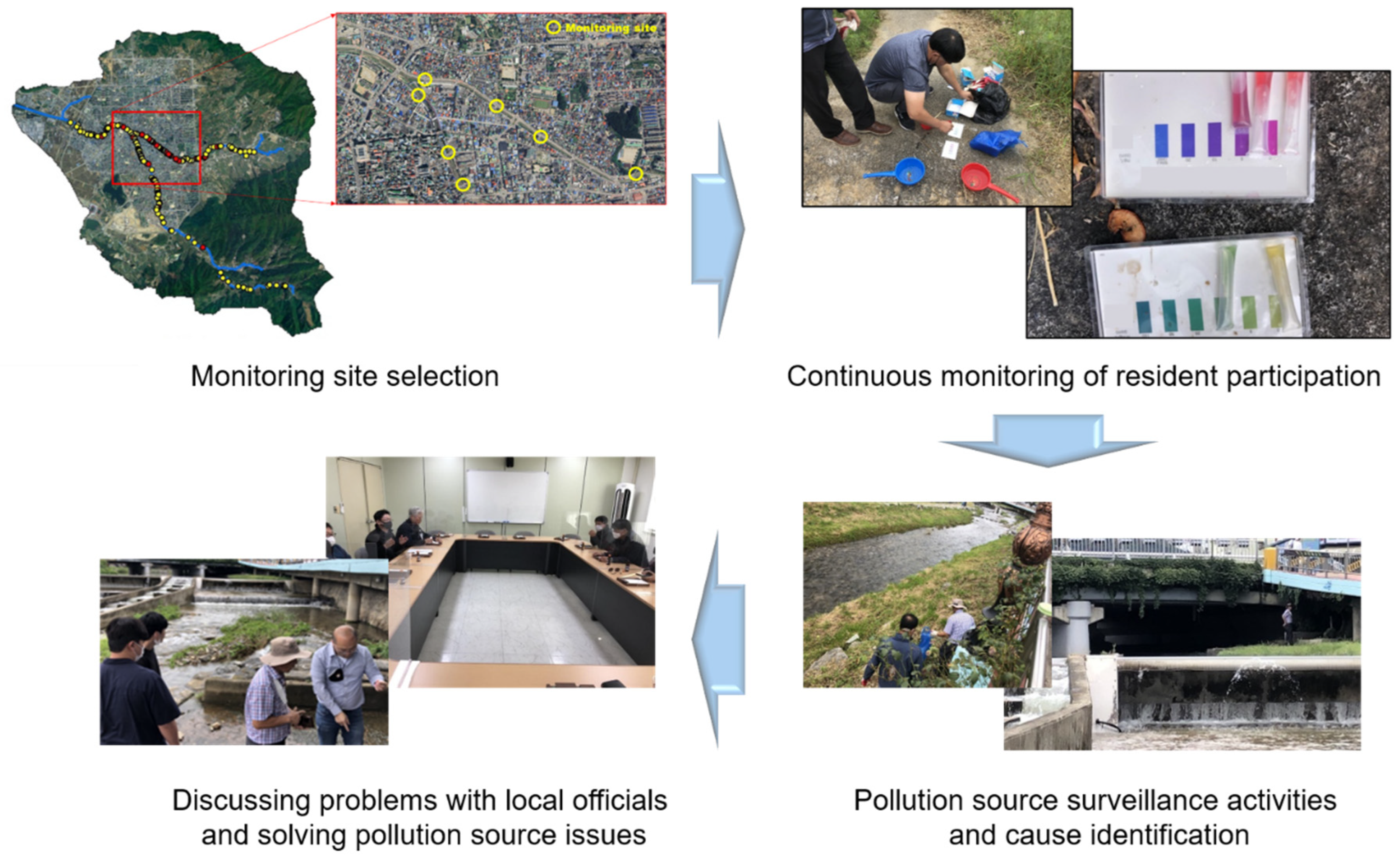
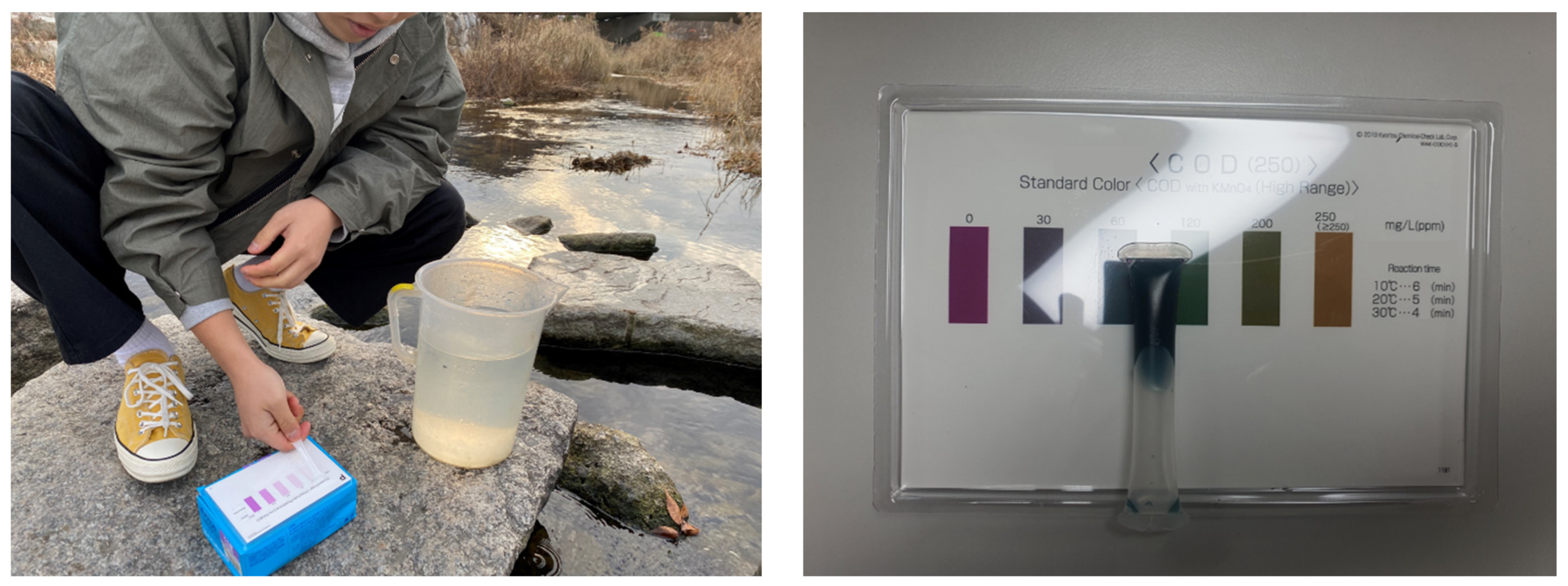



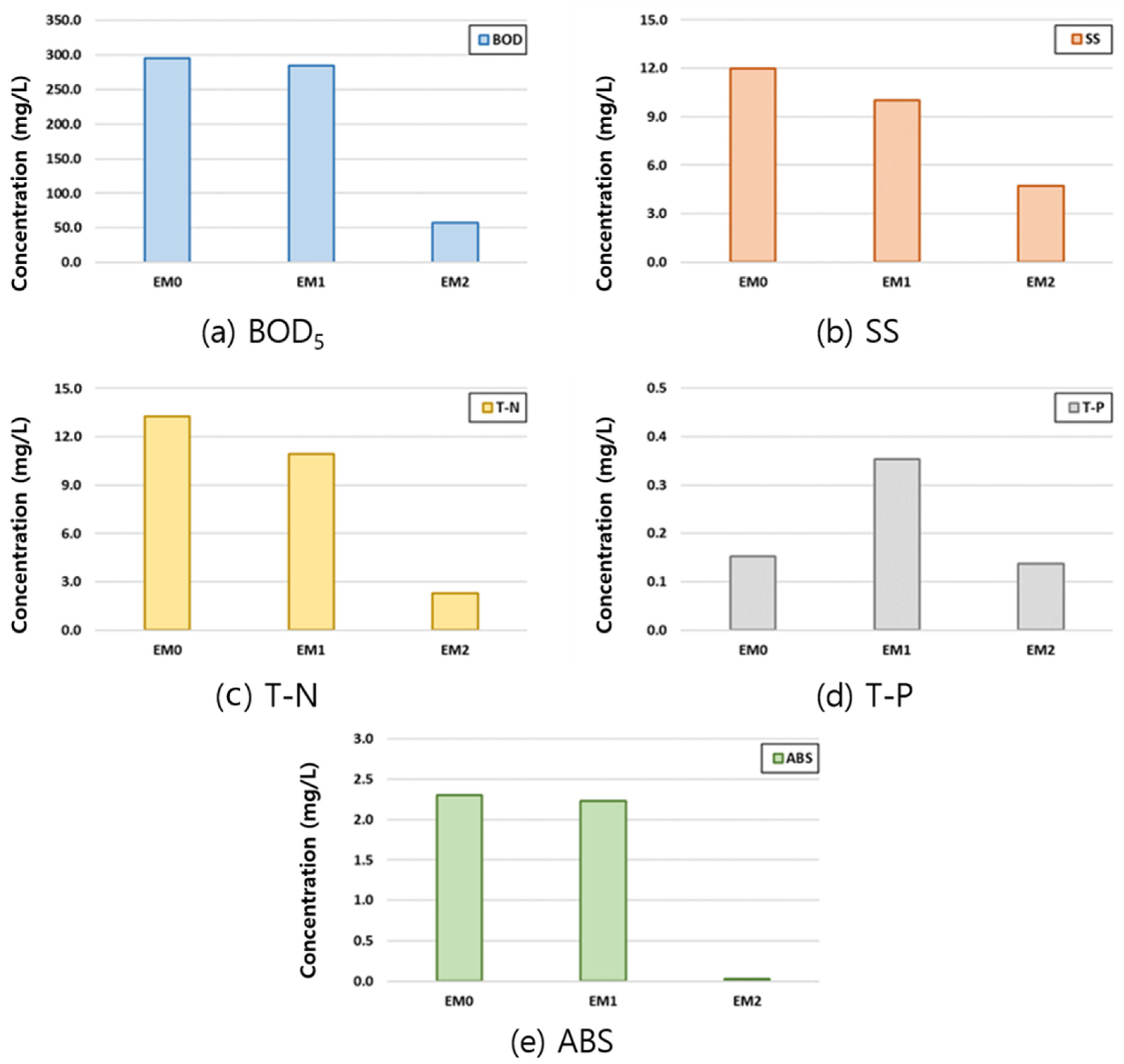
| Structural Measures | Non-Structural Measures | ||
|---|---|---|---|
| Category | Management Measures | Category | Management Measures |
| Artificial Wetlands | Water Purification Wetlands/Free Surface Wetlands | Common | Establishment and Operation of Resident Participation Governance |
| Sedimentation Facilities | On-line/Off-line Sedimentation Facilities | Livestock Sector | Operation Technology and Education Support for Self-treatment Facilities |
| Consulting for Individual Treatment Facilities | |||
| Vegetated Filtration | Vegetated Filtration Basin | Land Sector (Upper Agricultural Areas) | Non-point pollutant source BMPs (Best Management Practices) |
| Vegetated Ditch | Management of Agricultural Discharge | ||
| Infiltration Facilities | Infiltration Trench | Residential Sector | Management of Unknown Sources |
| Infiltration Reservoir | Water Conservation | ||
| Items | Measurement Method | Preservation Method | Max. Preservation Period | Instrument |
|---|---|---|---|---|
| Water temperature | Thermometer | - | Instantaneous | Multi-item Water Quality Meter (EXO1, YSI Inc., Yellow Springs, OH, USA) |
| DO | Electrode method | |||
| pH | ||||
| EC | 4 °C | 24 h | ||
| BOD5 | 48 h | DO meter (ysi-5000, USA) | ||
| SS | Fiberglass method | 7day | Drying Oven (SH-DO-150FS, SH Scientific, Sejong, Republic of Korea) | |
| T-N | Ultraviolet/visible spectroscopy—oxidation | 4 °C, H2SO4 pH2 or less | 28 day (7 day) | Autoclave and Spectrophotometer (LAC-5060SD and SM1600pc and HS3300., Labtech, Seoul, Republic of Korea and Azzota, Claymont, DE, USA) |
| T-P | Ultraviolet/visible spectroscopy | 28 day | ||
| Chl-a | Ultraviolet/visible spectroscopy | Filter immediately and store at −20 °C or below | 7 day (24 h) | Centrifuge and Spectrophotometer (800D and SM1600pc and HS3300., KOREA and USA) |
| Stream Name | BOD5 (kg) | Contribution Rate (%) | T-N (kg) | Contribution Rate (%) | T-P (kg) | Contribution Rate (%) |
|---|---|---|---|---|---|---|
| Gongji upstream | 578.0 | 23.2 | 2294.7 | 27.3 | 29.0 | 24.7 |
| Sinchoncheon | 510.8 | 20.5 | 2192.1 | 26.1 | 22.7 | 19.3 |
| Huhacheon | 375.3 | 15.1 | 971.7 | 11.6 | 16.3 | 13.9 |
| Toegyecheon | 530.7 | 21.3 | 2111.3 | 25.1 | 40.0 | 34.1 |
| Yaksacheon | 493.7 | 19.8 | 841.4 | 10.0 | 9.4 | 8.0 |
| Stream Name | BOD5 (kg) | Contribution Rate (%) | T-N (kg) | Contribution Rate (%) | T-P (kg) | Contribution Rate (%) |
|---|---|---|---|---|---|---|
| Chungju upstream | 2164.6 | 43.9 | 5316.3 | 37.9 | 89.0 | 37.5 |
| Gyohyeoncheon | 1403.0 | 28.4 | 5760.7 | 41.1 | 63.3 | 26.7 |
| Yeonsucheon | 1365.8 | 27.7 | 2950.2 | 21.0 | 84.7 | 35.7 |
Disclaimer/Publisher’s Note: The statements, opinions and data contained in all publications are solely those of the individual author(s) and contributor(s) and not of MDPI and/or the editor(s). MDPI and/or the editor(s) disclaim responsibility for any injury to people or property resulting from any ideas, methods, instructions or products referred to in the content. |
© 2024 by the authors. Licensee MDPI, Basel, Switzerland. This article is an open access article distributed under the terms and conditions of the Creative Commons Attribution (CC BY) license (https://creativecommons.org/licenses/by/4.0/).
Share and Cite
Kang, T.; Yu, N.; Shin, M.; Na, K.; Lim, K.J.; Kim, J. Design of Non-Structural Practices for Sustainable Water Quality Improvement in an Urban River: A Case Study of South Korea. Sustainability 2024, 16, 2298. https://doi.org/10.3390/su16062298
Kang T, Yu N, Shin M, Na K, Lim KJ, Kim J. Design of Non-Structural Practices for Sustainable Water Quality Improvement in an Urban River: A Case Study of South Korea. Sustainability. 2024; 16(6):2298. https://doi.org/10.3390/su16062298
Chicago/Turabian StyleKang, Taesung, Nayeong Yu, Minhwan Shin, Kyoungsoo Na, Kyoung Jae Lim, and Jonggun Kim. 2024. "Design of Non-Structural Practices for Sustainable Water Quality Improvement in an Urban River: A Case Study of South Korea" Sustainability 16, no. 6: 2298. https://doi.org/10.3390/su16062298
APA StyleKang, T., Yu, N., Shin, M., Na, K., Lim, K. J., & Kim, J. (2024). Design of Non-Structural Practices for Sustainable Water Quality Improvement in an Urban River: A Case Study of South Korea. Sustainability, 16(6), 2298. https://doi.org/10.3390/su16062298







